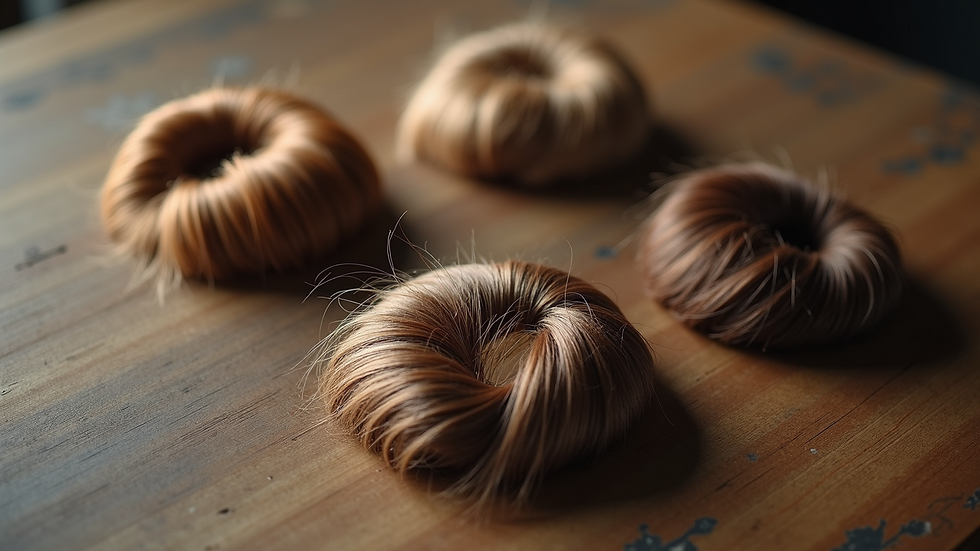A Comprehensive Guide to Choosing Hair Toppers
- elitehairtoppers
- May 19
- 4 min read
Choosing the right hair topper can dramatically change your appearance, providing that coveted confidence boost. Whether you're experiencing thinning hair, hair loss, or simply want a change in style, hair toppers can be an effective solution. However, with so many options on the market, it can be overwhelming to make the right decision. This guide aims to simplify the selection process, ensuring you find the perfect hair topper tailored to your needs.
Understanding Hair Toppers
Hair toppers are specially crafted pieces designed to cover thinning hair or bald spots on the head. They come in various types—synthetic, human hair, and blended materials. Synthetic toppers are usually more affordable but may not provide the same realistic appearance as their human hair counterparts. When selecting your hair topper, it’s essential to consider factors such as versatility, durability, and maintenance.

If you're new to the world of hair toppers, it's essential to understand the differences between various types available. Human hair toppers often blend seamlessly with your natural hair. This allows for styling versatility—whether you want straight, wavy, or curly hair, human hair toppers can meet those needs. Synthetic hair toppers, while typically less costly, may not have the same styling capabilities or longevity.
Types of Hair Toppers
There are several types of hair toppers available, catering to different hair concerns and preferences:
1. Clip-In Hair Toppers
Clip-in toppers are easy to use and can be inserted quickly for temporary changes. They are ideal for special occasions or when you want to add volume or length without commitment.
2. Toppers with Bases
These toppers come with different bases, including lace, silk, or polyurethane. The base material affects how the hair topper feels and how realistic it appears. Lace and silk bases often provide a more natural look, while polyurethane bases are durable and waterproof.
3. Integration Toppers
Integration toppers attach to your natural hair, allowing you to blend your strands with the topper for a seamless appearance. This is a great option if you want to maintain some of your hair's natural texture and volume.

4. Human Hair Toppers
Human hair toppers, while more expensive, offer the most natural look and feel. They can be dyed, styled, and treated like your own hair, which adds to their versatility. Finding the best human hair topper ensures you have a product that meets all your style needs.
How Much Should a Human Hair Topper Cost?
When investing in a hair topper, cost is an important consideration. Prices can vary significantly based on factors such as hair type, quality, and the intricacy of the construction. On average, a human hair topper can cost anywhere from $100 to over $1,200.
Budget Options: Expect to find basic human hair toppers starting around $100. These may not offer the highest quality but can be perfect for someone just testing the waters.
Mid-Range Options: Most quality human hair toppers fall into the $300 to $600 range. These toppers typically offer better craftsmanship and more realistic appearance.
High-End Options: For the best materials and advanced features, high-end human hair toppers can go upwards of $1,000. They will likely last longer and give a highly realistic look.
When making your decision, consider your budget alongside how often you plan to wear the topper. If you wear it daily, investing in a higher-quality product may save you money in the long run by avoiding frequent replacements.

Maintenance Tips for Hair Toppers
Once you've chosen the right hair topper, maintaining it properly will ensure that it lasts longer and retains its appearance. Here are some tips:
Washing: Regular washing (every 4-6 wears) with sulfate-free shampoo will help preserve the hair's natural oils and softness. Gently wash the topper under lukewarm water.
Conditioning: Use a good quality conditioner to keep the hair supple. Conditioners designed specifically for wigs or hair extensions are preferable, as they can prevent tangling and dryness.
Styling: Avoid high-heat styling tools on synthetic toppers, as they may cause damage. When styling human hair toppers, use heat protectant products to minimize damage.
Storage: When not in use, store your hair topper in a cool, dry place. Use a designated stand or box to maintain its shape.
Finding the Perfect Shade
One of the most critical aspects when choosing a hair topper is matching the shade to your natural hair color. Here are some steps to help you find the perfect match:
Consider Your Undertone: Hair colors usually fall into three categories—cool, warm, and neutral. Determine your undertone to identify which shade will blend best with your natural hair.
Use Samples: When shopping, request samples or swatches. You can compare them against your hair in natural light to see how well they match.
Take Your Time: Don’t rush this process. It’s essential to find a shade that feels right and blends seamlessly with your natural hair for the most realistic look.
Final Thoughts on Hair Toppers
Choosing the right hair topper can be an enriching experience that enhances your style and boosts your confidence. With various types available and ample options to suit every budget, understanding what works best for you is crucial. From knowing how much to spend to learning how to maintain your topper, this guide should serve as your roadmap.
Remember that a well-chosen hair topper can bring life to your style and provide you with the versatility you need for various occasions. Happy shopping!




Comments